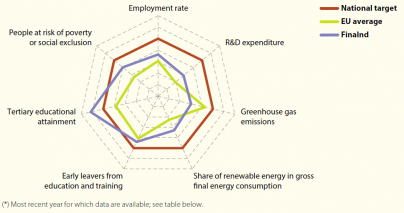Archive:Europe 2020 indicators - Finland
- Data from December 2014. Most recent data: Further Eurostat information, Main tables.
This article is part of a set of statistical articles based on the Eurostat publication Smarter, greener, more inclusive? - Indicators to support the Europe 2020 strategy
It provides recent statistics on the Europe 2020 strategy of the European Union (EU), focusing on the situation in Finland.

Main statistical findings
With 45.1 % of the population aged 30 to 34 having completed tertiary education in 2013, Finland continued to exceed its target of 42 %. However, its target is defined more narrowly than the EU target as it excludes former tertiary vocational education and training. Finland was also closer to its other national Europe 2020 targets than the EU average, except for GHG emissions in non-ETS sectors. Despite having the highest R & D intensity across the EU, the country in 2013 remained 0.68 percentage points from its national target. Its share of renewables in gross final energy consumption rose slightly between 2009 and 2012 but remained 3.7 percentage points from its national 2020 commitment. The country’s employment rate has remained between 73 % and 74 % since 2009, showing no progress towards the 78 % target. Similarly, progress towards the target on early leavers from education and training has been tentative since 2008. Despite a notable 15 percentage point reduction in GHG emissions in non-ETS sectors until 2012, the gap to the national target remained larger than in most other EU countries.
Data sources and availability
More information about the origin of the data and the calculation of indicators can be obtained via the Europe 2020 indicators dedicated website.
Under 'Tables', click on the icons next to the indicators:
- 'Explanatory texts (metadata)' for a detailed overview of the collection and compilation methods;
- 'Information on the leaf' for data availability per country.
A more general overview of quality procedures can be found in Implementation of standard reference metadata for indicators - the ESMS Indicator Profile (ESMS-IP) (PDF file).
See also
Further Eurostat information
Publications
- Smarter, greener, more inclusive - indicators to support the Europe 2020 strategy (online publication, also downloadable as PDF file)
Main tables
Dedicated section
Methodology / Metadata
- Towards robust quality management for European Statistics - Communication from the Commission to the European Parliament and the Council COM(2011) 211 final.
Other information
- Regulation 223/2009 of 11 March 2009 on European statistics
